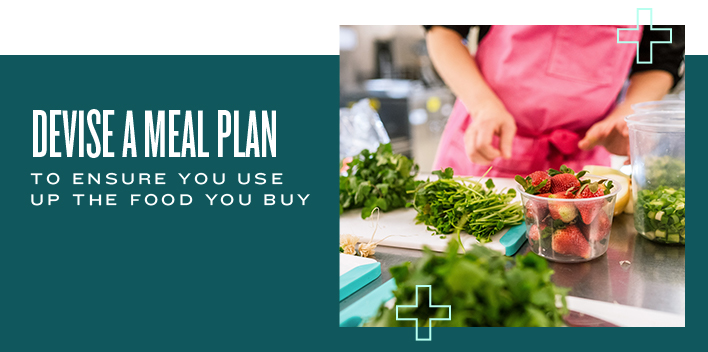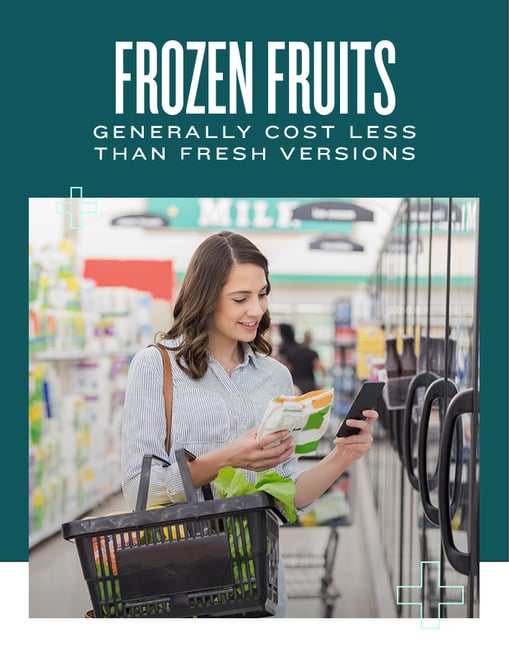You might have recently made a goal to eat healthier. Maybe you want to lose a few extra pounds, improve your cholesterol, or just avoid junk food. Though there are plenty of expensive diet plans out there promising an instant weight-loss solution, there are also realistic ways to change your eating habits that don’t cost much money at all.
You’ll get closer to both your financial and wellness goals when you identify a budget-friendly diet and fill your pantry with cheap, healthy foods. So, where should you start?
How to Identify a Budget-Friendly Diet
Before you go and make changes to your grocery shopping and eating habits, it helps to know what “budget-friendly” means when it comes to food. The United States Department of Agriculture (USDA) keeps track of people’s grocery spending and calculates the average cost of food eaten at home, based on four types of meal plans.
Under a “thrifty” food plan, a couple — represented in a USDA study as a male and female between the ages of 19 and 50 — spends an average of $403.20 per month on food eaten at home. A couple following a “moderate-cost” plan spends an average of $642.90 per month, while a couple on a “liberal” plan spends an average of $802.50 per month.

A diet that’s budget-friendly for you depends in large part on where you fall on the food-spending spectrum. If you’re near the “thrifty” end, keep an eye out for meals that feature affordable ingredients. If you’re comfortable spending on the “liberal” end of the spectrum, you might opt for higher-priced food options, such as meal kits with pre-chopped and portioned items, or plans with ingredients like more expensive cuts of meat or seafood.
There are a few signs that a diet you’re interested in will be budget-friendly.
- It features whole, unprocessed foods: Whole foods, such as dried beans and grains, are usually less expensive compared to processed or prepared foods. You’ll spend a lot less on a two-pound bag of brown rice than you would on a 16-ounce package of pre-cooked, frozen rice, for example. A can of beans or a pound of dried beans costs less than a four-pack of bean-based veggie burgers, as well. The ingredients to make a pot of soup are often less expensive than buying prepared soups by the carton or can.
- Most of the ingredients are plant-based: Plant-based foods, such as vegetables, beans, and grains, cost a lot less than meat. You don’t have to completely give up meat or go vegan to follow a healthy, budget-friendly diet, but it can be worth it to cut back on the amount of meat and other animal products you eat to save money on food. One thing to remember when adding more plant-based foods to your diet is to stick with whole foods when possible. Prepackaged and processed vegetarian “meats” or vegan “cheese” products can cost as much as their animal-based counterparts.
- It allows you to buy in bulk: Some stores sell dried foods, such as grains and beans, in bulk. You can buy as much or as a little as you want and pay for each item by the pound. Since bulk foods don’t have branding or packaging – beyond a paper or plastic bag – they usually cost less per pound compared to pre-packaged versions of the same foods.
- It encourages eating in-season: A budget-friendly diet will encourage you to eat seasonally, meaning it will feature plenty of recipes and ideas for meals based on the time of year. You’ll spend less on groceries when you buy food in-season. There tends to be an abundance of those foods, so it drives the price down.

Even if a diet isn’t inherently budget-friendly, there are often adjustments you can make to get it to work for you. For example, you can make a meat-heavy diet more affordable by choosing less-expensive cuts.
Budget-Friendly Grocery Shopping Tips
Along with choosing a diet plan that favors affordable foods, changing how you shop for groceries can help you stick to your budget. The following tips can help you save money at the supermarket, when purchasing healthy foods.

- Make and stick to a shopping list: If you’re following a specific diet, such as a plant-based diet or elimination diet, there are likely foods that you can and can’t eat. The restrictions of your current regimen can make it easier to compose a grocery list and to stick with it when you’re at the store. Only purchasing what’s on the list will help you avoid impulse buys, decreasing your food bill.
- Go shopping after you eat: Going to the store on an empty stomach can be a recipe for disaster. A hungry person will often buy more food than they need or can comfortably eat before it goes bad. Shopping while hungry can also cause you to veer away from your diet plan. Schedule your trips for right after a meal so that you’re less tempted by all the delicious-looking food in the store.
- Choose store brands when possible: Store brands or private label foods usually have a lower price tag compared to name-brand products, without being lower quality. If you haven’t already, try making the switch to store brands.
- Buy in bulk: Buying in bulk doesn’t necessarily mean coming home with a 30-pound bag of rice or a barrel of vegetable oil. It can mean buying the right amounts of the foods you use. If your diet calls for a lot of olive oil, you’ll save time and money by buying a larger bottle or tin compared to getting the smaller bottle more frequently. For dried foods, like beans and grains, buying from the bulk section saves you money by cutting out packaging. That allows you to purchase the exact amount you need.
- Skip the treats: If you’re on a diet to improve your health and lose weight, it’s a good idea to skip the candy, ice cream, and other treats you’re likely to encounter at the store. Not buying sweets and snacks is also good for your budget, as those foods tend to cost more than whole foods.
- Shop in the freezer aisle: The freezer aisles of the grocery store are home to frozen fruits and vegetables, which are usually budget-friendly and good to stock up on. When you have a freezer full of ready-to-go spinach, strawberries, and other types of produce, you’ll be able to put together a healthy, inexpensive meal quickly.
- Get strategic with sales: Many grocery stores put items on sale around a set schedule, enabling you to save money if you can time your purchases to the sale cycle. It pays to be smart about sales, however. Stick to buying food you like and will eat, not just the assortment of items that are discounted. It can also help to keep a pantry inventory to record what you have and what you need more of.
- Buy pantry staples: Some categories of foods are simply less expensive than others. You’ll save a lot and still eat well if you focus your shopping around these items. Grains, eggs, and beans are just a few examples of pantry staples that don’t cost a lot and are compatible with almost any type of diet.
- Change where you shop: It can pay to shop around, especially if there are multiple grocery stores within a short distance of your home. In the summer and early fall, for example, you might find better deals on in-season produce if you shop at a farmers’ market. Additionally, discount grocery stores may be able to give you a better price on your favorite foods.

Meal Planning Tips
Saving money at the supermarket is just the first step to making your diet more budget-friendly. If you bring home all that food and don’t end up eating it, your money is going to waste.
The next step is devising a meal plan. This doesn’t just ensure you use up the food you buy, though. It can also help you stick to your diet and make healthier eating choices. You’ll be a lot less likely to call for take-out or mindlessly snack instead of having a healthy dinner if you have meals prepped and ready to go.

Here’s what you can do to streamline your meal planning and preparation process.

- Pick your meals: The first step when meal planning is to choose the meals you’ll be making and eating over the next week. To save money, shop your pantry first, then look at the sales flyers to see what ingredients are marked down, before you make your list and start shopping. You’ll spend a lot less if you can make food with what’s already in your fridge and pantry, compared to running out to buy more. Another thing to consider when choosing your meals is to skip over any that call for specialized or strange ingredients that you might never use again.
- Dedicate one day as prep day: The beauty of a meal plan is that you do the work up front, then get to relax for the rest of your week. With that in mind, pick a day to be meal planning day. It can be a weekend or weekday evening – whenever you have time to pick your meals, do the shopping, and start prepping. You might also decide to split the task up over a couple of days, doing the shopping on one day and the prep work the next.
- Allow for some flexibility: Meal planning doesn’t mean you need to eat every single meal at home or make everything from scratch. Once you get your grocery budget under control, you might find that you have some wiggle room for the occasional meal out. It’s possible to over-plan, so be sure to give yourself some space for repeat meals or food-on-the-go, as needed.
- Know what you like to eat: Keep it simple when meal planning and prepare the type of dishes that work with your diet and that you know you and others in your household like eating. It’s perfectly acceptable to eat some version of beans and rice every day if you like it, for instance.
- Prep extra: Just as buying certain ingredients in bulk helps you save money, so does cooking in bulk. Make more chili or soup than you’ll eat during the week and freeze the extra. You’ll have meals ready to go during periods of life when you might be busier than usual, allowing you to stick with your diet even in times of stress.
- Have a leftovers plan: To keep food waste to a minimum, build a plan for leftovers into your weekly meal plan. You might designate Saturday night as leftover night, for example, or eat any food left over from dinner for lunch the following day.
- Use an app: A meal-planning app can help you get organized with meal prep, among other benefits. Search for a free one that allows you to store your favorite recipes, easily pick and choose options to create meal plans for each week based on ingredients and calories, have your grocery list automatically generated, and sync grocery delivery.
Budget-Friendly Foods
As you go about making your meal plan and planning your shopping list, it helps to know what foods are the most budget- and diet-friendly. While some types of diets entail skipping certain foods, such as carbohydrates, eggs, or any animal products, many allow you to eat and enjoy the most affordable foods available.

- Rice: Whether white or brown, long grain or short grain, rice is a very affordable pantry item. You can add a side of brown rice to a meal to increase the fiber and nutrition or develop a meal around a serving of rice, such as a brown rice bowl with beans and roasted vegetables.
- Eggs: Eggs can be another affordable pantry item. You can use eggs in a lot of ways, such as adding a soft-boiled egg to a grain bowl or whipping up a veggie-filled frittata. Although some diets exclude eggs, such as a purely plant-based vegan diet, they are part of many other healthy eating plans.
- Dried beans: Like rice, dried beans are budget-friendly and flexible. You can use dried lentils to make a curry you serve with rice or to make lentil soup. Black beans can be cooked and transformed into black bean burgers, a filling for tacos, or a topping for salads. Chickpeas are the starring ingredient in hummus.
- Canned beans: Canned beans cost a little bit more than their dried cousins, but they’re still very inexpensive. They also save you a lot of time in the kitchen, as they don’t need to be soaked or cooked before preparation.
- Frozen fruit: In season, fresh fruit can be a healthy and relatively inexpensive treat. However, the price of fresh fruit tends to climb in the winter, when it needs to be shipped in from distant, warmer locations. Frozen fruit provides a more wallet-friendly solution. You can use it to make smoothies or put in baked goods. Frozen fruits generally cost less than fresh versions. They also have a longer shelf-life and are less likely to go bad before you can use them.
- Frozen vegetables: Like frozen fruits, frozen vegetables provide a budget-friendly way to get more greens into your diet, without breaking the bank. You can use frozen vegetables in pretty much any recipe that calls for fresh ones.
- Jarred pasta sauce: In many cases, it’s more economical to buy jarred pasta sauce than it is to make your own from scratch. Pasta sauce is budget-friendly and has a long shelf life, meaning you can stock up on jars of sauce when they go on sale.
- Pasta: Pasta is another cheap pantry staple. If you’re concerned about too many simple carbs, you can choose a variety that’s made from whole grains. Alternative kinds of pasta, made from ingredients like lentils and chickpeas, are designed to be compatible with certain types of diets while remaining budget-friendly.

How to Stick to Your Diet on a Budget
Dieting and budgeting can mix, but there might be times when one or the other goes off course. You might spend more than you planned during a shopping trip or you might overindulge one day on treats or snacks. Here’s how to get back on track.
- Recommit to your meal plan: Life can interfere with the best-laid diet plans. If you’re feeling stressed and don’t have time to eat right or stick to your diet, give yourself a chance to recommit to meal planning and preparation. Having a stockpile of healthy meals ready to go in your freezer means you’ll be able to quickly get something on the table on busy days.
- Take a close look at what’s in your pantry and fridge: If you buy foods you’re trying to avoid on your diet, you’re likely to eat them. Take stock of what’s in your pantry and refrigerator to see if there’s anything in them that you’re trying to avoid. If so, clear out the foods you don’t want to eat. You can give them away to friends or family members who aren’t on the same diet or bring them to the break room at the office for co-workers to enjoy.
- Give yourself some room for error: It can be easier to stick to a strict diet when you give yourself some breathing room. If you get cravings for foods that aren’t exactly “allowed” on your current eating plan, work some cheat days into the schedule. You might also give yourself a certain day of the week to enjoy dessert, pizza, or take-out.
- Remember your why: Knowing and reminding yourself of the reasons why you’re on a particular diet can make it easier to sustain. When you’re feeling discouraged or that chocolate bar is calling, remembering your reasons can help you stay on track.
- Always pack a snack: Keep a few healthy, diet-friendly snacks in your purse or bag so that you have something to eat when hunger strikes. Being prepared with snacks will help you avoid getting something to go or grabbing a candy bar at the checkout counter.
- Keep track of what you eat: Even if the particular diet plan you’re following doesn’t call for a food journal, it can be helpful to keep track of what you eat each day. Having a journal holds you accountable for your diet and makes you more likely to stick with it, even when you want to throw in the towel.

PSECU Can Help You Live Your Best Financial Life
Reaching your health and wellness goals doesn’t have to mean spending a lot on food. If you want to adjust your food budget and eat better, take some time to plan your meals. You can have plenty of affordable, healthy options available and prevent the food you buy from going to waste.
Check out our WalletWorks page for more budget-friendly tips.
The content provided in this publication is for informational purposes only. Nothing stated is to be construed as financial or legal advice. Some products not offered by PSECU. PSECU does not endorse any third parties, including, but not limited to, referenced individuals, companies, organizations, products, blogs, or websites. PSECU does not warrant any advice provided by third parties. PSECU does not guarantee the accuracy or completeness of the information provided by third parties. PSECU recommends that you seek the advice of a qualified financial, tax, legal, or other professional if you have questions.

